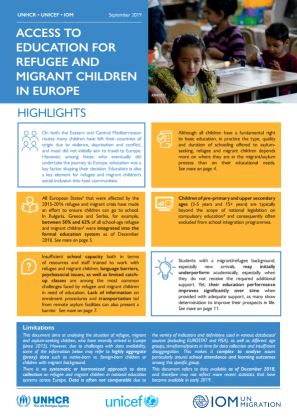-
Countries
-
Data and Analysis
-
Special Focus
-
Crisis Responses
Europe — Access to Education for Refugee and Migrant Children in Europe (September 2019)
IOM, the International Organization for Migration, UNHCR, the UN Refugee Agency and UNICEF, the United Nations Children’s Fund detail the obstacles children and adolescents born outside Europe face when trying to access education in Europe.
Currently the number of children and adolescents born outside Europe (including recently arrived refugee and migrant children) who leave school early is nearly twice as high compared to native-born children. Migrant children also have lower learning outcomes when they are not given adequate support. For example, around 3 in 4 native-born students attain proficiency in science, reading and math but only 3 in 5 students with a migrant background do.
Among the key challenges highlighted in the report are:
- Insufficient financial resources
- Not enough school spaces or teachers trained to work with refugee and migrant children
- Language barriers
- A lack of psychosocial support and limited catch-up classes. The latter are vital for children who have missed extended periods of schooling or have come from different education systems.
Children of pre-primary age (3 to 5 years old) and upper secondary age (15 years and older) are particularly vulnerable to being out of school, as they are often beyond the scope of national legislation on compulsory education.
To help States tackle these challenges and address key data gaps, the paper gives examples of good and promising practices in education across Europe and makes a series of recommendations.
